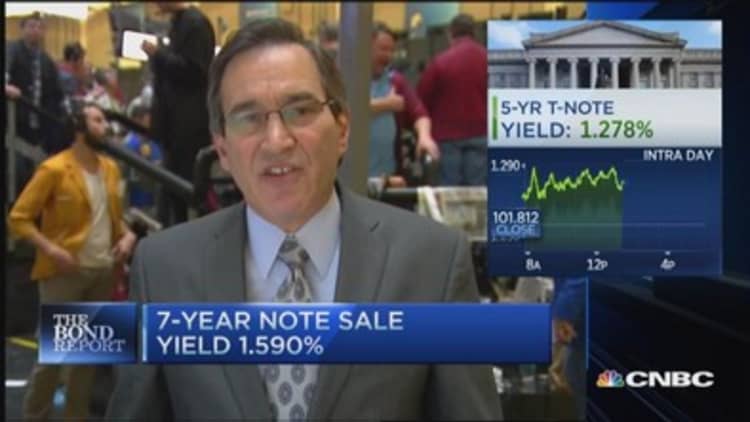The relentless fall in longer term U.S. Treasury yields doesn't signal declining U.S. inflation expectations, but instead is a side effect of funds fleeing low yields elsewhere, say analysts.
"Yields of U.S. Treasury's have actually become increasingly appealing relative to those of government bonds in other developed countries," Capital Economics Chief Markets Economist John Higgins said in a note published last week.
"Increased appetite from overseas investors" have contributed – along with the now-phased out asset purchases by the Federal Reserve and extra demand from banks in response to the launch of Basel 3 - to the downward pressure on U.S. Treasury yields, he said.
At the longer end, 10-year Treasury yields broke below the key 1.7 percent level and closed at 1.6329 percent. The 10-year Treasury's are just a tad off levels seen in early March 2013, before the Fed first broached the idea that it would begin tapering its purchases of Treasury's, a process it completed in October of last year. The 30-year was seen at 2.2229 percent, close to a record low.

In comparison, massive central bank bond purchase operations in Japan and Europe have sent yields tumbling, especially in Germany and Japan, where they are still hovering around record lows: the 10-year German bund yields just 0.304 percent and the 10-year Japanese Government Bonds (JGB) are at 0.290 percent. At the 30-year end, German yields are at 0.887 percent and its Japanese equivalent at 1.280 percent. Another central bank joined in two weeks ago – yields on Swiss government bonds sunk into the negative after a surprise rate cut and scrapping of its currency peg to the euro.
ECB accelerates hunt for…a yield
The latest catalyst was the European Central Bank's (ECB) decision on January 22 to flood its financial system with an open-ended 60 billion euro ($68 billion) bond buying program, set to expand monthly.
The action was widely anticipated, but larger than expected. "The sheer size of the additional demand from the ECB for European sovereigns -- relative to the additional supply -- helps explain why global bond yields fell so dramatically in 2014," said Morgan Stanley U.S. interest rate strategist Matthew Hombach in a note published on January 23.
Read MoreUS Treasury yields fall after ECB unveils bond-buying
In the fiscal year 2014, the U.S. Treasury market saw "extra measurable" foreign investment flows of $179 billion, according to a January 23 note by Bank of Tokyo-Mitsubishi Chief Financial Economist Christopher Rupkey citing Treasury TIC data.
At 1.14 percent, the G10 Gross Domestic Product-weighted 10-year yield has never been lower, "not even during the Great Recession," according to Hombach.
Will yields head upwards again?
Whether U.S. Treasury yields will start rising again depends on investors' expectations of when inflation in the Euro zone may start recovering, which in turn would eliminate the reason the ECB embarked on a quantitative easing program, said analysts.
The ECB is targeting an inflation rate of "below, but close to 2 percent" in the medium term. But prices in the Eurozone continue to fall: in January, inflation was -0.6 percent in the negative on an annualized basis.
"If investors believe the ECB will purchase bonds well into 2017, given the inflation outlook, bond yields will keep falling – globally," said Morgan Stanley's Hombach. To reverse the trend, "both the movements in realized inflation and medium-term inflation expectations would have to surprise to the upside," he said.
An extension of the ECB program would also "imply further dollar appreciation and more sustained import price-led disinflation in the U.S.," said Capital Economics' Higgins.
As a result, yields on U.S. Treasury's "will probably remain subject to downward pressure from the low returns available on bonds in other countries," he said.

